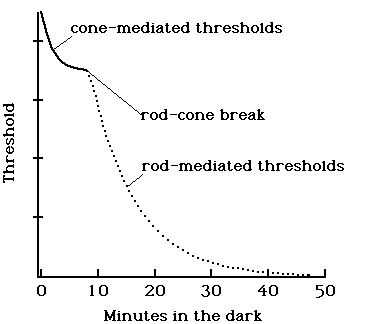Sensation and Perception
Sensory Adaptation
Sensory Adaptation occurs when sensory receptors change their sensitivity to the stimulus. This phenomenon occurs in all senses, with the possible exception of the sense of pain.
Dark Adaptation
Dark adaptation, or adaptation to reduced light intensity, involves three distinct changes
in the visual system:
- Enlargment of the pupil -- takes place immediately. The larger pupil allows more of the available light to enter the eye and stimulate the retina.
- Increased sensitivity of the cones (color receptors) of the eye -- In low levels of illumination, the light-sensitive chemical in the cones increases in concentration. This makes it more likely that molecules of the chemical will be struck by particles of light (photons), initiating a chemical cascade that signals the detection of light by the receptor. Cones become completely dark-adapted within about five to ten minutes, but at best remain unresponsive to the levels of light present at night or in a darkened theater, resulting in a loss of color vision under those conditions.
- Increased sensitivity of the rods (night-vision receptors) of the eye -- As with the cones, the rods contain a light-sensitive chemical whose concentration increases under low light-levels, leading to increased sensitivity. Rods become fully dark-adapted after about 20-30 minutes.
 The increased sensitivity produces a reduced threshold for detecting light. The figure to right shows the falling threshold values as a function of time spent in darkness. The left part of the curve is produced by adaptation of the cones, the right part by adaptation of the rods.
The increased sensitivity produces a reduced threshold for detecting light. The figure to right shows the falling threshold values as a function of time spent in darkness. The left part of the curve is produced by adaptation of the cones, the right part by adaptation of the rods.
Rods and cones have different spectral sensitivities. Objects that in color would appear to be blue-green look brighter to the rods than they do to the cones, because rod sensitivity peaks in the brue-green region of the color spectrum. To make a scene shot in the daylight look like a moonlit scene, movie cameramen shoot the scene in black and white, with a filter over the lens that allows blue-green light to enter the camera better than other colors, making objects of that color appear relatively brighter, compared to other objects, than they do when seen in daylight.
Rods are blind to red light. Thus, to view a map at night without disturbing the dark-adaptation of the rods ("night vision"), illuminate the map in red light. Because the rods do not "see" the red light, they remain fully dark adapted.
Light Adaptation
As with dark adaptation, light adaptation involves (a) an immediate change in pupil size (it becomes smaller, admitting less light), (b) a change in the sensitivity of the cones to light (it decreases), and (c) a change in the sensitivity of rods to light (it also decreases). Because the large number of photons entering the eye rapidly destroy any excess light-sensitive chemical, light adaptation takes only a couple of seconds, rather than the many minutes required for dark adaptation.
Other Examples of Sensory Adaptation
- Hearing -- loud sound causes a small muscle attached to one of the bones of the inner ear to contract, reducing the transmission of sound vibrations to the inner ear, where the vibrations are detected. (This protective mechanism does not work well for sudden very loud noises such as rifle shots, as the muscle does not have time to contract before the intense vibrations pass through.)
- Touch -- We quickly adapt to hot and cold stimulation, if it is not too intense. The bath that was almost too hot to enter soon feels too cool; similarly, the cold lake we jump into for a summer swim feels freezing at first, but soon feels only refreshingly cool.
- Smell -- We can detect amazingly low concentrations of some chemicals in the air (e.g., perfumes) but although the perfume is still in the air about us, we quickly cease to detect it.
Adaptation in Hand-Eye Coordination
Distorting goggles make an object that may be straight in front appear to be several degrees off to left or right. If you try to throw a ball to another person while wearing these goggles, you initially throw wide of the mark. However, with practice, you learn to readjust the relationship between where you see the person standing and the feel of the motion of your arm as you throw, and are then able to throw the ball directly toward the person. However, take the goggles off and initially you will now throw wildly off in the _opposite_ direction from your initially wild throws with goggles on. With a couple of practice throws you quickly readjust again.
 The increased sensitivity produces a reduced threshold for detecting light. The figure to right shows the falling threshold values as a function of time spent in darkness. The left part of the curve is produced by adaptation of the cones, the right part by adaptation of the rods.
The increased sensitivity produces a reduced threshold for detecting light. The figure to right shows the falling threshold values as a function of time spent in darkness. The left part of the curve is produced by adaptation of the cones, the right part by adaptation of the rods.